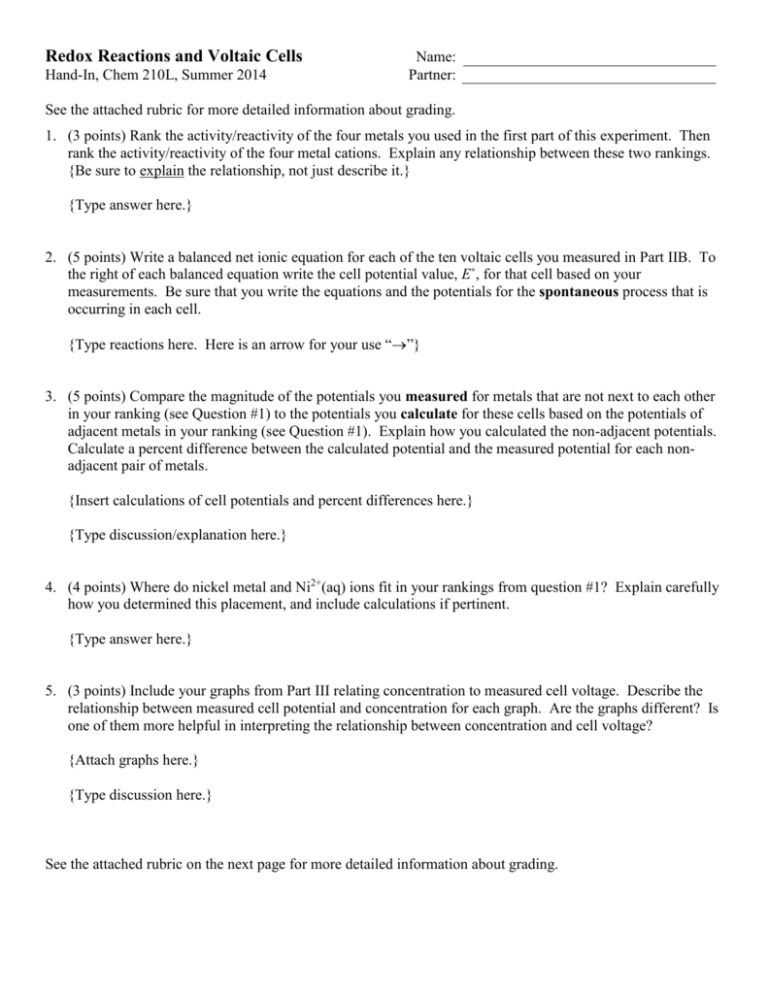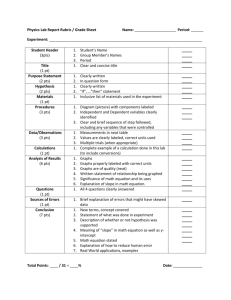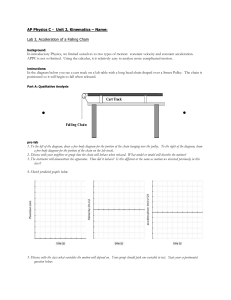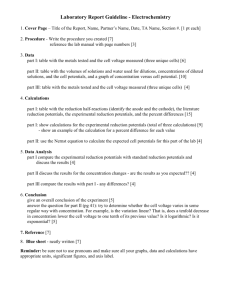Chemistry 165 * Determination of Molar Mass by Freezing Point
advertisement

Redox Reactions and Voltaic Cells
Hand-In, Chem 210L, Summer 2014
Name:
Partner:
See the attached rubric for more detailed information about grading.
1. (3 points) Rank the activity/reactivity of the four metals you used in the first part of this experiment. Then
rank the activity/reactivity of the four metal cations. Explain any relationship between these two rankings.
{Be sure to explain the relationship, not just describe it.}
{Type answer here.}
2. (5 points) Write a balanced net ionic equation for each of the ten voltaic cells you measured in Part IIB. To
the right of each balanced equation write the cell potential value, E˚, for that cell based on your
measurements. Be sure that you write the equations and the potentials for the spontaneous process that is
occurring in each cell.
{Type reactions here. Here is an arrow for your use “”}
3. (5 points) Compare the magnitude of the potentials you measured for metals that are not next to each other
in your ranking (see Question #1) to the potentials you calculate for these cells based on the potentials of
adjacent metals in your ranking (see Question #1). Explain how you calculated the non-adjacent potentials.
Calculate a percent difference between the calculated potential and the measured potential for each nonadjacent pair of metals.
{Insert calculations of cell potentials and percent differences here.}
{Type discussion/explanation here.}
4. (4 points) Where do nickel metal and Ni2+(aq) ions fit in your rankings from question #1? Explain carefully
how you determined this placement, and include calculations if pertinent.
{Type answer here.}
5. (3 points) Include your graphs from Part III relating concentration to measured cell voltage. Describe the
relationship between measured cell potential and concentration for each graph. Are the graphs different? Is
one of them more helpful in interpreting the relationship between concentration and cell voltage?
{Attach graphs here.}
{Type discussion here.}
See the attached rubric on the next page for more detailed information about grading.
Unsatisfactory
Q #1
Rankings
Borderline
Rankings are both
incorrect and the
relationship between
the rankings is not
explained.
0 points
No equations
balanced properly.
1 point
Q #2
Eqn’s.
Q #3
Nonadjacent
E˚s
Q #4
Ni
placement
Q #5
Conc.
effect
Total
0-1 points
No E˚ calculations
or no explanation
given.
2 points
Mistakes in E˚
calculations and
explanation not clear.
Satisfactory
Excellent
-1 for each incorrect
ranking.
-1 for noting
relationship between
rankings but not
explaining it.
Each ranking is correct
and the relationship
between the two ranks is
explained well.
2 points
-0.5 pt. for any reaction
not balanced.
-0.5 pt. for any reaction
not written as a
spontaneous reaction
with the correct sign of
E˚.
3 points
Net-ionic equations are all
properly balanced and
written as spontaneous
reactions.
3-4 points
Correct calculation of E˚
values but no percent
difference calculation or
explanation not clear.
5 points
Clear, correct calculations
of E˚ values with clear
explanation and percent
difference determined
correctly.
3 pts.
5 pts.
0-1 points
Ni not placed
properly in the
activity series and
no supporting
explanation or data.
2-3 points
Ni placed properly in
the activity series but
no data provided in
support of placement.
4 points
Ni placed properly in
the activity series but
not supported clearly
with student’s data.
5 points
Ni placed properly in the
activity series and
placement supported with
student’s data.
0-1 points
No graphs included.
2 points
Only 1 point if graphs
are not scatter graphs.
3 points
Good graphs but unclear
or missing discussion.
4 points
Clear, well labeled graphs
and discussion of graphs.
1 point
2 points
3 points
0 points
Score
5 pts.
4 pts.
3 pts.
20 pts







